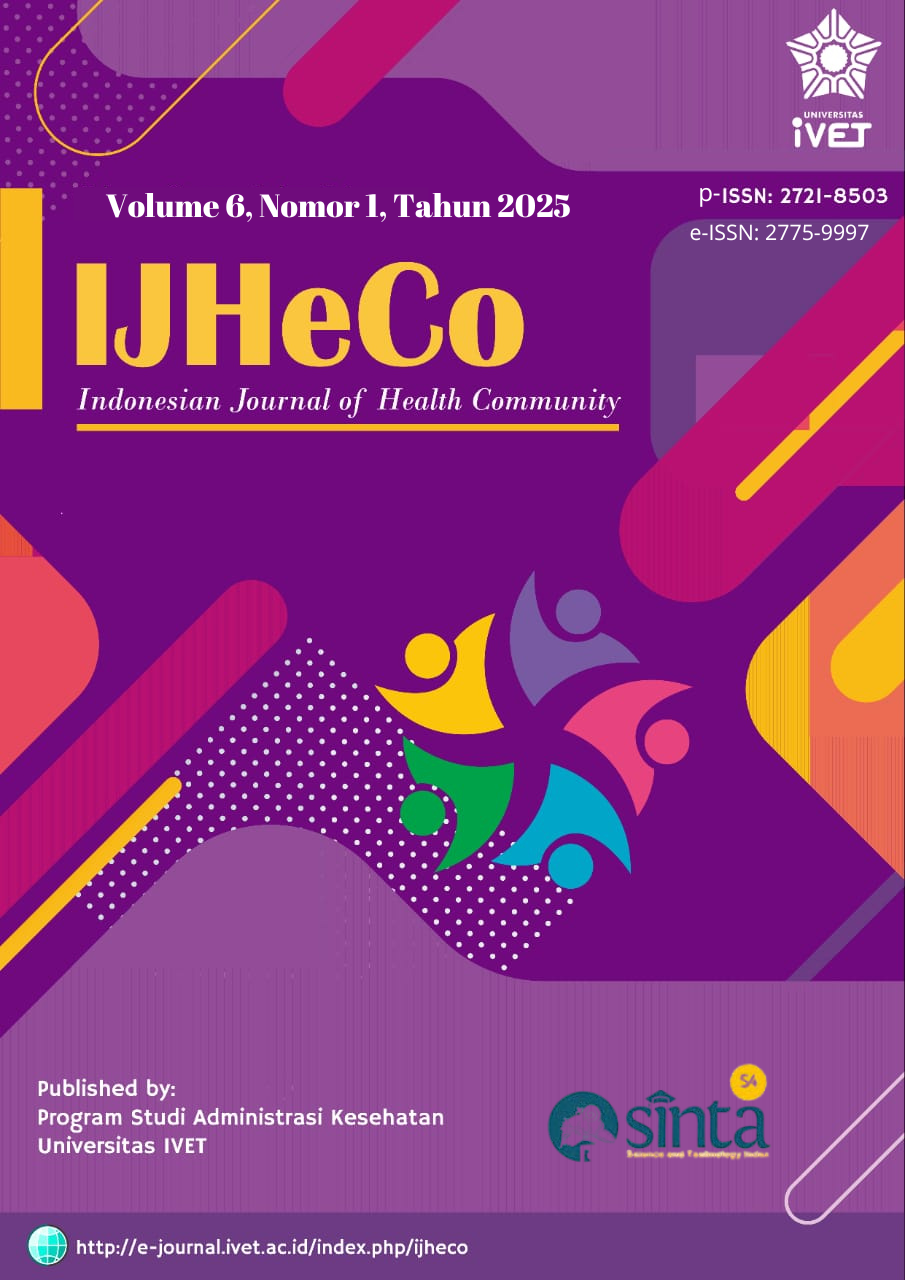Gambaran Status Gizi Dan Perilaku Konsumsi Minuman Manis Siswa MI Di Pondok Tahfidz Saffiyan Hafiyya Ogan Ilir
Abstract
Diabetes mellitus is one of the chronic diseases that is no longer limited to the adult age group but is also increasingly found in the child population. Modern lifestyle changes, especially the consumption patterns of high-sugar but low-nutrient beverages, have become the main factor contributing to the rise of diabetes mellitus cases at an early age. Data from the Indonesian Pediatrician Association (IDAI) shows that as many as 1,645 children in Indonesia have been diagnosed with diabetes, spread across 13 major cities. This study aims to explore the consumption habits of sweet beverages and assess the nutritional status of students at MI Pondok Saffiyan Haffiya. The research approach used is descriptive quantitative with a cross-sectional design and total sampling technique. The findings show that as many as 3 students (5%) are in the overweight category. The consumption habits of sweet drinks in the last week include: boxed milk consumed by 26 students (74.3%), soft drinks like Coca-Cola or Sprite by 8 students (22.9%), sweet tea by 15 students (42.9%), ice cream by 16 students (45.7%), and boba drinks by 10 students (28.6%). Obesity in children is generally caused by an imbalance between energy intake and expenditure, especially due to the consumption of high-sugar drinks without sufficient physical activity. Therefore, interventions through nutrition education and the promotion of healthy lifestyles from an early age are crucial strategies in efforts to prevent diabetes mellitus in children.
References
AIPGI. (2017). Gizi Anak Sekolah. Ilmu Gizi Teori dan Aplikasi. EGC.
Almira, A. (2017). Hubungan antara konsumsi minuman ringan dengan obesitas pada siswa Sekolah Dasar (Skripsi, Universitas Trisakti). Repository Universitas Trisakti.
Ayu, R., Basuki, R., & Susilowati, A. (2020). Penelitian gizi dan makanan. Nutrition and Food Research, 43(1), 29–40. https://www.neliti.com/publications/223576/hubungan-asupan-energi-lemak-dan-serat-dengan-rasio-kadar-kolesterol-total-hdl
Calcaterra, V., Cena, H., Magenes, V. C., Vincenti, A., Comola, G., Beretta, A., Di Napoli, I., & Zuccotti, G. (2023). Sugar-Sweetened Beverages and Metabolic Risk in Children and Adolescents with Obesity: A Narrative Review. Nutrients, 15(3), 1–19. https://doi.org/10.3390/nu15030702
Faizi, M., La, Z. T., Puteri, H. A., Waladhiyaputri, V., Amalia, G., Tjahjono, H. A., Rochmah, N., Fadiana, G., Hisbiyah, Y., Perwitasari, R. K., Mutaqin, F., Khairunnisa, Salim, I. A., Heryana, A. Y., & Pulungan, A. B. (2025). Understanding the burden faced by families of children living with Type 1 diabetes mellitus in Indonesia: A multidimensional study on the financial, social, and psychosocial aspects. Clinical Pediatric Endocrinology, 34(1), 45–53. https://doi.org/10.1297/cpe.2024-0071
Fatmah, F., Lestari, W., & Nugraheni, S. A. (2020). Konsumsi Minuman Berpemanis dan Status Gizi Anak Sekolah Dasar. Media Gizi Indonesia, Https://Doi.Org/10.20473/Mgi.V15i1.2020.45-52, 15(1), 45–52.
International Diabetes Federation (IDF). (2021). IDF Diabetes Atlas (10th ed.).
Irvania, L. (2017). Identifikasi Status Gizi Anak Usia Sekolah Di SDN 18 Kendari Barat Kota Kendari Provinsi Sulawesi Tenggara.
Kao, K. T., Sabin, M. A. (2019). Hypertension and Type 2 Diabetes Mellitus in Children and Adolescents. Pediatric Type II Diabetes, 45(6), 37–45.
Kementerian Kesehatan Republik Indonesia. (2018). Hasil Utama Riskesdas 2018. Badan.
Marchamah, Dwi Nur Siti; Dewi, Restu Ayu Eka Pustika; Arumsari, Wahyuni. 2025. “Peran Komunikasi, Informasi, Dan Edukasi Serta Konselor Sebaya Dalam Meningkatkan Efektivitas Program Pelayanan Kesehatan Peduli Remaja.” Jurnal Kesehatan Medika Saintika 16(1):60–72. doi:10.30633/jkms.v16i1.3097.
Muazizah, Y. N., Cahyati, Y., Arsyi, N., & Wardeni, R. (2022). Meningkatkan Kualitas Hidup Pasien Diabetes Melitus Melalui Self Care Management. Jurnal Penelitian Kesehatan Suara Forikes, 13(Khusus), 8–14.
Perkumpulan Endokrinologi Indonesia. (2015). Konsesus Pengelolaan dan Pencegahan Diabetes Melitus Tipe 2 Di Indonesia. (ID) PB Perkeni.
Rukajat, A. (2018). Pendekatan Penelitian Kuantitatif: Quantitative Research Approach. Deepublish.
Saifah, A et al. (2019). Peran Keluarga Perhadap Perilaku Gizi Anak Usia Sekolah. 2, 83-92.
Susanti, N., Saragih, I. A. P., Sikumbang, E. S., & Faiza, M. (2024). Hubungan Konsumsi Minuman Manis dan Faktor Risiko Diabetes pada Remaja. Prepotif: Jurnal Kesehatan Masyarakat, 8(2), 3457–3462.
Syahroni, M. H. A., Astuti, N., Indrawati, V., &, & Ismawati, R. (2021). Faktor-Faktor Yang Mempengaruhi Kebiasaan Makan Anak Usia Prasekolah (4-6 Tahun) Ditinjau Dari Capaian Gizi Seimbang. J. Jurnal Tata Boga, 10(1), 12–22. https://ejournal.unesa.ac.id/index.php/jurna%0Al-tata-boga/%0A
UNICEF. (2025). Building blocks for lifelong health?: Why we must prioritize children Call to action for the private sector.
US Preventive Services Task Force. (2022). Screening for Prediabetes and Type 2 Diabetes in Children and Adolescents: US Preventive Services Task Force Recommendation Statement. JAMA, 328(10), 963–967. https://doi.org/doi:10.1001/jama.2022.14543
Valeriani, D., Prihardini Wibawa, D., Safitri, R., & & Apriyadi, R. (2022). Menuju Zero Stunting Tahun 2023 Gerakan Pencegahan Dini Stunting Melalui Edukasi pada Remaja di Kabupaten Bangka. Jurnal Pustaka Mitra, 2(2), 84–88.
Yoshida, Y., & Simoes, E. J. (2018). Sugar-Sweetened Beverage, Obesity, and Type 2 Diabetes in Children and Adolescents: Policies, Taxation, and Programs. Current Diabetes Reports, 18(6). https://doi.org/10.1007/s11892-018-1004-6




